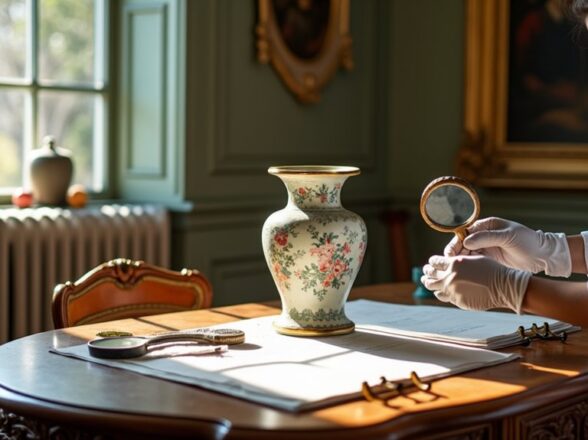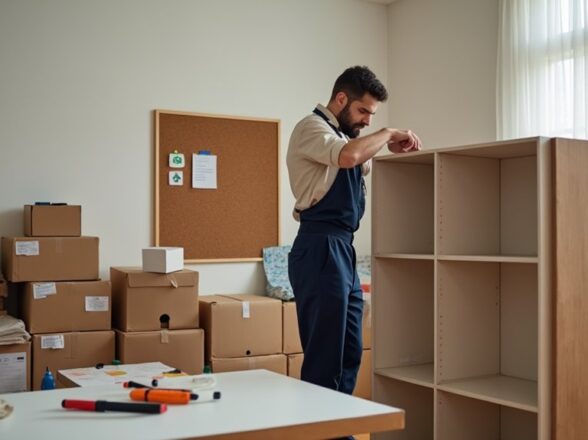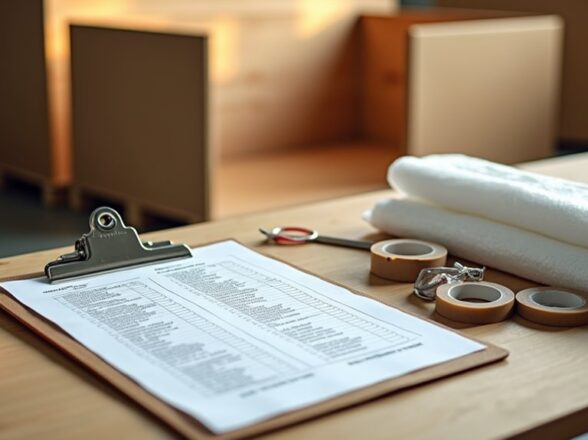How to Prepare Your Art and Antiques for Moving? A Complete Pre-Move Checklist

To prepare your art and antiques for moving, start by evaluating their value with professional appraisals. Create a detailed inventory that includes photographs, dimensions, and conditions. Check local legal requirements for transporting valuables and confirm you have proper permits. Use heavy-duty boxes and acid-free packing materials for safe cushioning. Protective measures like corner protectors and disassembling furniture at break points are essential. On moving day, review your inventory, communicate care instructions to movers, and monitor climate control. After unpacking, inspect all items against your inventory. You'll find additional tips for a smooth process in the following sections.
Understanding the Value of Your Items

Understanding the value of your art and antiques is fundamental before you move. Many owners don't realize that only about 40% know their current market value. Obtaining appraisals from professionals like the International Society of Appraisers or the Appraisers Association of America is essential. These appraisals provide not just financial worth but also help with insurance coverage. The market value can change due to economic conditions, so staying informed is critical. A detailed inventory of your items, including appraisals, safeguards against loss during your move. Specialized insurance policies can cover your items' appraised worth, including restoration costs, which standard moving insurance often doesn't. Understanding these aspects guarantees you're fully prepared for the relocation of your valued items. It is also important to consider using climate-controlled storage facilities to ensure the protection of sensitive items during transport, especially for fine art and antiques.
Planning for Legal Requirements
Before you start packing your art and antiques, it's crucial to reflect on the legal requirements that come with transporting these valuable items. Each state has different regulations, so you'll need to guarantee compliance. Here are some key points to ponder:
- Permits: Check if you need special permits for transporting certain materials or historically significant items.
- Customs Regulations: For international transport, familiarize yourself with customs regulations and obtain necessary certifications.
- CITES Compliance: If your items involve endangered species, make sure you follow CITES rules to avoid legal issues.
Consulting with professional moving services can help navigate these complex legal requirements. This way, you can secure a successful antique transport without facing penalties or confiscation. Professional movers in Dubai can provide tailored services to ensure your art and antiques are transported safely and in compliance with international regulations.
Creating an Inventory Checklist

Once you’ve navigated the legal requirements for transporting your art and antiques, the next step is to create a detailed inventory checklist. Start by documenting each item carefully. Include high-resolution photographs, dimensions, and current conditions to guarantee you have a thorough record for insurance and legal purposes. Don’t forget to note unique qualities and historical significance, as this information is vital for appraisals and insurance claims. Use a numbering system to correlate photos with descriptions, making it simpler to track items. Regularly update your inventory as you pack, noting any changes in condition. Store both a digital and hard copy of your inventory checklist in a secure location for easy access during the move and for future reference. For optimal preservation, ensure your items are packed with high-quality materials like acid-free paper and bubble wrap, as these are crucial for protecting fragile and valuable pieces during transit. Additionally, familiarize yourself with the regulations and customs procedures of the countries you are shipping to and from, as this knowledge can significantly impact how to transport art internationally. Consider consulting with a logistics expert specializing in fine art to ensure compliance with all necessary documentation and best practices for international shipping. By taking these precautions, you can minimize risks and ensure that your valuable pieces arrive at their destination safely and securely.
Essential Packing Supplies
When preparing to move your art and antiques, having the right packing supplies is vital to assure their safety. Here's a list of must-have items to protect your items during the move:
- Heavy-duty boxes: Use high-quality boxes in various sizes to guarantee a snug fit for your items, preventing movement during transport.
- Bubble wrap and crumpled paper: These materials provide essential cushioning for fragile pieces. Use multiple layers of bubble wrap for added protection.
- Packing tape, labels, and markers: Strong packing tape is necessary for securely sealing boxes. Labels and markers help you identify contents and handling instructions.
Additionally, use acid-free tissue paper and packing peanuts to safeguard delicate surfaces and fill empty spaces, reducing the risk of damage. Consider using custom-built crates for large or irregularly shaped antiques to ensure minimal movement and maximum stability during transport.
Techniques for Safe Packing

When packing art and antiques, using specialized wrapping materials is essential for their protection. You should layer cushioning techniques to absorb shocks and secure your items in snug boxes to prevent movement. Following these methods will help guarantee your valuables arrive safely at their destination.
Specialized Wrapping Materials
To guarantee your art and antiques arrive safely at their new destination, using specialized wrapping materials is essential. These materials provide protection during transit and help prevent damage. Here are three key items to use:
- Acid-free tissue paper: Wrap delicate items to prevent deterioration and discoloration during transport.
- Bubble wrap: Utilize high-grade bubble wrap with multiple layers for fragile artwork and antiques, ensuring adequate cushioning against impacts.
- Glassine paper: For oil paintings and sketches, wrap them in Glassine paper, which offers a moisture-resistant barrier without causing damage.
Finally, secure all packing materials with heavy-duty packing tape to keep everything intact. Consider custom crating for valuable pieces, using sturdy materials for maximum protection.
Layered Cushioning Techniques
After wrapping your art and antiques with specialized materials, it's time to focus on layered cushioning techniques that enhance protection during the move. Begin with delicate items by using multiple layers of bubble wrap, ensuring edges are fully covered to prevent damage. For fragile antiques, wrap them first with packing paper or foam before applying bubble wrap for extra security.
Fill empty spaces in boxes with crumpled paper or biodegradable packing peanuts to keep items stationary. Use heavy-duty packing tape to secure all layers of cushioning, ensuring that everything stays in place. For valuable pieces, consider custom crating with triple-walled cardboard or plywood crates.
| Layer | Purpose |
|---|---|
| Bubble Wrap | Cushioning delicate items |
| Packing Paper | Initial wrap for fragile antiques |
| Crumpled Paper | Fills empty spaces |
| Heavy-duty Tape | Secures cushioning layers |
Secure Packing Procedures
Properly securing your art and antiques during packing is essential for ensuring they arrive at your new location unharmed. Follow these secure packing procedures for fragile items:
- Wrap each piece in acid-free packing paper before using multiple layers of high-quality bubble wrap for cushioning. Make sure to cover all edges.
- Invest in custom crating for high-value pieces, using triple-walled cardboard or plywood for maximum protection.
- Fill empty spaces in boxes with crumpled packing paper or biodegradable packing peanuts to prevent movement.
Label boxes clearly with contents and handling instructions. This careful handling helps prevent damage. If you're unsure, consider hiring professional movers who specialize in art and antiques. Remember, insurance provides peace of mind during the move.
Importance of Professional Movers
When you’re preparing to move valuable art and antiques, hiring professional movers is essential for safeguarding your treasures. These experienced movers specialize in handling delicate items, which can reduce the risk of damage or loss by up to 75%. They use industry-standard packing materials designed specifically for fragile goods, ensuring your valuable items are well protected. Additionally, licensed and insured moving companies provide extra security during the relocation process. With attention to detail, professional movers also offer insurance coverage for high-value items, giving you peace of mind. Their expertise in logistics management helps navigate complex legal requirements related to transporting culturally significant pieces. Overall, professional movers are key to protecting your valuable art and antiques during a move. By opting for fine art moving services, you not only benefit from their specialized training in handling unique items, but also gain access to customized solutions tailored to your specific needs. These services often include climate-controlled transportation and specialized crates that safeguard against environmental factors that could potentially harm your art pieces. Ultimately, investing in fine art moving services means ensuring that your invaluable treasures arrive at their new destination unscathed and ready to be displayed. Moreover, the types of art movers handle extend beyond just paintings and sculptures to include a wide array of collectibles, such as antiques, rare textiles, and even installations. Their extensive knowledge of various materials and forms allows them to apply the appropriate techniques for each item, whether it requires specialized handling or specific environmental conditions. By choosing experienced professionals, you ensure that every piece of your collection is treated with the utmost care, allowing you to enjoy your art for years to come without worry.
Special Considerations for Antiques

When moving antiques, it's essential to start with a thorough inventory and documentation. You should assess each item for existing damage and choose the right packing materials, like acid-free tissue paper and bubble wrap, to guarantee their safety. Specialized packing techniques, such as custom crating for valuable pieces, can provide extra protection during transport.
Inventory and Documentation
Creating a detailed inventory is essential for any move involving antiques. This guarantees you recognize the value and condition of each piece. Follow these steps to create an effective inventory:
- Take high-resolution photographs of each item, noting dimensions and current condition.
- Document any existing damages with clear photographs and notes for insurance claims.
- Keep records of appraisals conducted by recognized professionals to establish market value.
Organized documentation also helps with permits and regulations when transporting culturally significant items. This thorough approach safeguards your valuable antiques against damage or loss during relocation. By maintaining accurate records, you can easily assess your collection's condition and value both during and after the move.
Specialized Packing Techniques
Packing antiques requires specialized techniques to guarantee their safety during a move. Use acid-free packing materials like tissue paper and bubble wrap to protect delicate surfaces. For high-value antiques, consider custom crating with triple-walled cardboard or plywood for added impact protection. Disassemble furniture at natural break points, documenting the process with photos for easy reassembly. Protect fragile items with corner protectors and secure them using heavy-duty packing tape to prevent damage during transit. Always secure loose components, such as knobs and handles, with shrink wrap or padded blankets before packing. If you're unsure about the process, hiring professional services can assure your antiques are packed safely and securely, reducing the risk of damage.
Moving Day Procedures
As you prepare for moving day, it's crucial to review your complete inventory list to guarantee every item is accounted for and ready for transport. Confirm that you have specialized art insurance and any necessary legal permits for delicate items. Communicate specific care instructions to the professional moving team, emphasizing the need for careful handling of fragile and high-value pieces. During transport, monitor the climate-controlled vehicle's conditions to protect your items from humidity and temperature fluctuations that could cause damage.
Here's a quick checklist to follow:
- Review your inventory list.
- Confirm insurance and permits.
- Communicate care instructions to the movers.
Following these steps will help guarantee a smooth moving day.
Post-Move Inspection Process

After your move, it's essential to inspect all your art and antiques carefully. Start by removing the packing materials and comparing each item against your pre-move inventory to check for any missing or damaged items. Document any discrepancies right away, as this information will be important for dealing with your insurance provider.
Damage Assessment Procedures
A thorough damage assessment is essential immediately following your move to secure the safety and integrity of your art and antiques. Start by comparing the condition of each piece against your pre-move photographs. Follow these steps to document any visible damage:
- Inspect each item carefully for existing damage while using a soft brush to remove packing debris.
- Take high-resolution photographs of any damage you find and write detailed notes for your insurance claims.
- Notify your insurance provider promptly to meet any time-sensitive reporting requirements and retain all documentation.
Retaining documentation, including photographs and notes, will help facilitate the claims process and guarantee you receive adequate compensation for any losses incurred during the move.
Inventory Comparison Checklist
Following the damage assessment, it's time to conduct an inventory comparison checklist to confirm everything is accounted for and in the expected condition. Start by comparing each item against your pre-move inspection photographs and notes. Check off each item on your inventory checklist, noting any missing pieces to report to the moving company right away. Document damages with detailed photographs and descriptions, as this will support any insurance claims. Cross-reference your list with appraisals done prior to the move to guarantee high-value antiques are properly evaluated. Keep records of your post-move inspection findings, including dates and communications with the moving company. This will provide accountability and help protect your investments during changes involving packing supplies and specialized knowledge.
Insurance Options for Protection
When moving valuable art and antiques, securing the right insurance is essential for your peace of mind. Standard moving insurance often falls short, covering only 60 cents per pound. Instead, consider these insurance options:
- Specialized art insurance: This can cover the appraised worth of your items, including restoration costs if needed.
- Professional appraisals: Obtain appraisals from recognized organizations like the International Society of Appraisers to determine the accurate value.
- Consider historical importance: High-value art often requires specialized restoration skills for adequate protection.
Insurance provides a financial cushion and emotional assurance, safeguarding your valuable items during the moving process. Make sure you choose a policy that fits the unique needs of your art and antiques.
Frequently Asked Questions
How Do You Prepare Art for Moving?
To prepare art for moving, create an inventory checklist, use protective materials, and label artwork clearly. Consider climate control, choose safe transportation methods, and guarantee proper insurance coverage with professional movers for secure storage solutions.
How to Transport Antiques?
When you transport antiques, use bubble wrap and secure crates for fragile handling. Employ professional movers, guarantee climate control, and consider insurance coverage. Create an inventory list and choose appropriate transportation methods to protect your valuable items.
What to Do When Preparing for a Move?
As you envision a sea of packed boxes, gather your packing supplies and create an inventory checklist. Consult professional movers for cost estimates, assess insurance options, and label boxes carefully, ensuring fragile items're protected throughout your moving timeline.
How to Move Large Pieces of Art?
To move large pieces of art, hire professional movers who use custom crates and protective materials. Guarantee climate control during transportation, document conditions for insurance coverage, and apply proper handling techniques for safe art packing.
Conclusion
In summary, preparing your art and antiques for a move requires careful planning and execution. Following the steps outlined in this checklist guarantees your items are protected during transport. Many believe that packing is just about wrapping items tightly, but proper inventory and legal considerations are equally essential. By taking these precautions, you can minimize potential risks and guarantee your valuable possessions arrive safely at their new home.
Related posts
Typical Timeline for a Warehouse Move
Warehouse Moving Checklist: Essentials
Recent posts
Post Categories
Tags
Subscribe











